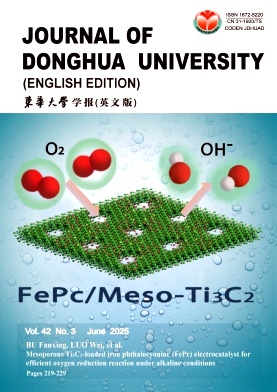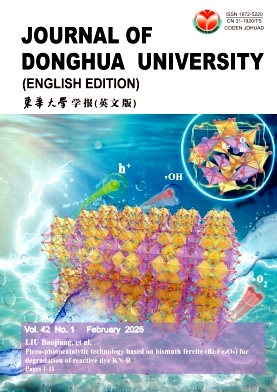Poly(Octamethylene Citrate)-Based Elastomer Microspheres via Spray-Drying of Chitin Nanocrystal Constructed Pickering Emulsion
GUAN Yu;GUO Furong;LIANG Kai;JI Yali;Poly(octamethylene citrate)(POC) is a promising bioelastomer material in the biomedical field. However, its thermosetting nature poses a significant challenge to processing and molding, especially manufacturing the POC-based elastomer particles as potential, degradable and toughened fillers. Firstly, a Pickering emulsion with a pre-polymer(pre-POC) solution in dimethyl carbonate as a dispersed oil phase, a Pullulan(PUL) aqueous solution as a continuous water phase, and chitin nanocrystal(ChiNC) as a particle-type emulsifier was constructed. Secondly, the POC-based core/shell structured microspheres were prepared by spray-drying of the emulsions, and characterized by a scanning electron microscope and a transmission electron microscope. Finally, the POC-based core/shell structured microspheres were used as elastomer fillers to strengthen and toughen a chitosan film, resulting in 26% increase in the tensile strength and 45% increase in the strain at break; the POC-based core/shell structured microsphere as a double-layer drug release system was built in which the hydrophilic drug of tetracycline hydrochloride(TCH) was released from the outer layer and the hydrophobic drug of curcumin was released from the inner layer, roughly following the Ritger-Peppas model.
F-B Co-Doped TiO2 Nanosheets Bounded with Highly Active Anatase(001) Facets for Improved Photocatalytic Hydrogen Evolution
ZHANG Mengyao;WEI Li;LIU Lei;F-B co-doped TiO2 nanosheets with exposed anatase(001) facets were synthesized via a one-pot solvothermal method, and their photocatalytic hydrogen evolution performance was investigated. Characterization results confirm that this method effectively promotes the growth of the highly active anatase(001) facets and enhances visible and infrared light absorption while inducing oxygen vacancies. Under optimal conditions, the hydrogen evolution reaches 20.57 μmol after 10 h of ultraviolet-visible(UV-Vis) light irradiation, exceeding the commercial TiO2 nanoparticles Degussa P25 by more than 10 times. These findings highlight the potential of F-B co-doped TiO2 nanosheets for efficient photocatalysis.
Analysis of Three Reactive Dyes and Their Six Derivatives by Capillary Electrophoresis
HUANG Shuqing;SHEN Li;XU Zhongqi;Reactive dyes with different reactive groups exhibit different hydrolysis and dyeing behaviors. This is particularly evident in the combination dyeing process, where the competion between hydrolysis and dyeing reactions increases the complexity. Therefore, developing an effective method to monitor the changes in reactive dyes during the dyeing process is important. This study aims to develop a capillary electrophoresis(CE) technique combined with an ultraviolet(UV) detector(CE-UV) for detecting three reactive dyes and their six derivatives(a total of nine analytes). The optimized CE conditions are 20.0 mmol/L sodium tetraborate(Na_2B_4O7·10H_2O), acetonitrile(ACN) with a volume fraction of 15.0%, 20.0 mmol/L α-cyclodextrin(α-CD), and at a pH value of 9.0(adjusted with 0.5 mol/L H_3BO3). The limit of detection(LOD)(a signal-to-noise ratio of 3) for the nine analytes ranges from 1.38 to 5.06 mg/L. The relative standard deviations(RSDs) for peak areas and migration time are 2.19%-4.96% and 0.29%-2.75%, respectively. The method is capable of accurately identifying three reactive dyes and their six derivatives and monitoring alterations in composition and dyeing behavior during single and combination dyeing processes.
Preparation and Power Frequency Shielding Effectiveness of Stainless Steel Conductive Fabric
YANG Yang;ZHANG Yan;ZHANG Ruiyun;JI Feng;LI Wenjun;XU Xiaoyuan;In order to prepare the shielding fabrics with high efficiency of power frequency(PF) shielding and excellent electrical conductivity, different ratios of aramid/stainless steel fiber blended yarns were used to weave the shielding fabrics with different specifications. The fabric structure, fabric areal density, number of fabric layers, embedding ratio of copper-clad wires wrapped aramid yarns(denoted as CCWWA) and embedding direction were designed, and a total of 34 different types of shielding fabrics were woven for testing. The experiments were mainly conducted to study the influence mechanism of various factors on the PF shielding effectiveness by testing the electrical conductivity and PF shielding effectiveness of the fabrics. The research results indicate that the PF shielding effectiveness improves with increasing fabric areal density and metal fiber content. The fabrics embedded with CCWWA, particularly those with bidirectional embedding, exhibit a significant enhancement in the PF shielding effectiveness, showing an increase of 8-20 dB compared to the fabrics without CCWWA. The PF shielding effectiveness varies across different fabric structures, with plain weave fabrics demonstrating the superior PF shielding effectiveness due to their compact structure. Non-conductive base fabric has minimal impact on the PF shielding effectiveness. As the number of fabric layers increases, the PF shielding effectiveness initially improves but then declines, peaking with double-layer fabrics.
Hydrogen Sensing Characteristics of Gas Sensor Based on Pt/Graphene Composite
HOU Tianhao;PENG Yitian;DING Shuyang;Graphene has exceptional electrical, optical and thermal properties, and is widely used to create thinner, lighter and faster sensors. In this study, graphene was fabricated by mechanically exfoliating on the Si O2/Si substrate and the graphene field effect transistor(FET) was prepared by photolithography. Platinum(Pt) particles were doped on the surface of graphene by the hydrazine hydrate reduction method to endow a Pt/graphene sensor with gas-sensing properties. By being tested on a gas detection platform, the characteristics of the electrical(I-V) curves and resistance response curves were obtained in different hydrogen environments. The results show that the Pt/graphene sensor exhibits a high sensitivity to hydrogen at room temperature, with a resistance response rate of 33. 35% at a hydrogen volume fraction of 1. 00%. However, the sensitivity lifetime study shows an essential hysteresis in desorption process, which leads to gradually decreases in the resistance response rate. This research provides an improved production method of graphene-based gas sensors, which has a wide range of potential applications in aero-space industry.
MLGIA:Recognition of Traffic Panel Information Based on PaddlePaddle
JI Yukai;GE Huayong;MENG Yaqun;LI Sisi;To address the challenge of recognizing small target information on traffic panels, a model named MLGIA is proposed based on Paddle Paddle. MLGIA is composed of Mobilenet V3 with lightweight Ghost Block(LGB) and an improved augmented feature pyramid network(IAFPN). In this model, LGB improves Mobilenet V3 by optimizing the convolutional structure and employing linear transformations to extract sufficient feature maps; IAFPN enhances feature representation through pruning techniques and channel-reduction convolutions. Additionally, knowledge distillation compresses the model and improves its accuracy, while the match category information(MCI) method further optimizes the processing of the detected category information. Experimental results demonstrate that MLGIA outperforms Mobilenet V3. MLGIA achieves a detection accuracy comparable to YOLOv8n, with significantly lower resource consumption. Therefore, MLGIA is a strong complement in the traffic panel information recognition domain.
Security Defenses for Cross-Technology Communication in IoT Control System
LI Tianyun;ZHANG Anqi;ZHANG Guanglin;To solve security problems in cross-technology communication(CTC), we take the Internet of Things(IoT) control system as an example, and propose a comprehensive solution against the attack on the physical layer CTC from ZigBee to Wi-Fi. Specifically, we propose a noise interference strategy by adding an appropriate amount of dedicated noise signals, which can interfere with the eavesdropping and simulation of ZigBee signals without affecting the reception of the receiver. Moreover, we also propose a regression modeling strategy which collects data, extracts features, and trains a binary logistic regression model so that the receiver can actively distinguish simulated attack signals. We build the experimental platform by using GNU Radio and USRP devices. Experimental results demonstrate that the security defense strategies can identify and distinguish the signals from the attacker with a high accuracy, effectively solving the signal emulation attack on the physical layer CTC from ZigBee to Wi-Fi.
Select-and-Answer Prompting:Facilitating LLMs for Improving Zero-Shot Reasoning
WANG Yufang;TANG Xuesong;HAO Kuangrong;Large language models(LLMs) have demonstrated remarkable generalization abilities across multiple tasks in natural language processing(NLP). For multi-step reasoning tasks, chain-of-thought(CoT) prompting facilitates step-by-step thinking, leading to improved performance. However, despite significant advancements in LLMs, current CoT prompting performs suboptimally on smaller-scale models that have fewer parameters. Additionally, the common paradigm of few-shot CoT prompting relies on a set of manual demonstrations, with performance contingent on the quality of these annotations and varying with task-specific requirements. To address these limitations, we propose a select-and-answer prompting method(SAP) to enhance language model performance on reasoning tasks without the need for manual demonstrations. This method comprises two primary steps: guiding the model to conduct preliminary analysis and generate several candidate answers based on the prompting; allowing the model to provide final answers derived from these candidate answers. The proposed prompting strategy is evaluated across two language models of varying sizes and six datasets. On ChatGLM-6B, SAP consistently outperforms few-shot CoT across all datasets. For GPT-3.5, SAP achieves comparable performance to few-shot CoT and outperforms zero-shot CoT in most cases. These experimental results indicate that SAP can significantly improve the accuracy of language models in reasoning tasks.
Subgraph Matching on Multi-Attributed Graphs Based on Contrastive Learning
LIU Bozhi;FANG Xiu;SUN Guohao;LU Jinhu;Graphs have been widely used in fields ranging from chemical informatics to social network analysis. Graph-related problems become increasingly significant, with subgraph matching standing out as one of the most challenging tasks. The goal of subgraph matching is to find all subgraphs in the data graph that are isomorphic to the query graph. Traditional methods mostly rely on search strategies with high computational complexity and are hard to apply to large-scale real datasets. With the advent of graph neural networks(GNNs), researchers have turned to GNNs to address subgraph matching problems. However, the multi-attributed features on nodes and edges are overlooked during the learning of graphs, which causes inaccurate results in real-world scenarios. To tackle this problem, we propose a novel model called subgraph matching on multiattributed graph network(SGMAN). SGMAN first utilizes improved line graphs to capture node and edge features. Then, SGMAN integrates GNN and contrastive learning(CL) to derive graph representation embeddings and calculate the matching matrix to represent the matching results. We conduct experiments on public datasets, and the results affirm the superior performance of our model.
Graph-Based Transform and Dual Graph Laplacian Regularization for Depth Map Denoising
MENG Yaqun;GE Huayong;HOU Xinxin;JI Yukai;LI Sisi;Owing to the constraints of depth sensing technology, images acquired by depth cameras are inevitably mixed with various noises. For depth maps presented in gray values, this research proposes a novel denoising model, termed graph-based transform(GBT) and dual graph Laplacian regularization(DGLR)(DGLRGBT). This model specifically aims to remove Gaussian white noise by capitalizing on the nonlocal self-similarity(NSS) and the piecewise smoothness properties intrinsic to depth maps. Within the group sparse coding(GSC) framework, a combination of GBT and DGLR is implemented. Firstly, within each group, the graph is constructed by using estimates of the true values of the averaged blocks instead of the observations. Secondly, the graph Laplacian regular terms are constructed based on rows and columns of similar block groups, respectively. Lastly, the solution is obtained effectively by combining the alternating direction multiplication method(ADMM) with the weighted thresholding method within the domain of GBT.
Static Characteristic Analysis of Aerostatic Porous Bearing with a Restricted Layer
YU Zhe;YAN Ruzhong;MA Xiaojian;ZHANG Haojie;To enhance the gas-damping effect and improve the bearing performance, a restricted layer is applied on the surface of aerostatic porous bearings. Based on the gas lubrication theory, a mathematical model of an aerostatic porous bearing with a restricted layer is established, and two proportional coefficients, a permeability ratio δ and a thickness ratio γ, are proposed. Critical values of δ and γ are determined through sensitivity analyses of complex restriction-layer parameters. The static characteristics of aerostatic porous bearings with a restricted layer or an unrestricted layer are comparatively analyzed by using Fluent simulation. The results show that when δ ≈ 0.005 and γ ≈ 0.010, the load capacity and static stiffness of the restricted-layer aerostatic porous bearing are high; compared with the unrestricted-layer aerostatic porous bearing, the restricted-layer aerostatic porous bearing has a lower sensitivity to changes in the air supply area. The existence of the restricted layer not only enhances the throttling effect and reduces the mass flow rate, but also effectively improves the static stiffness of the bearing.
Automated Bionic Wig Weaving Process Design and Weaving Path Planning
LYU Hongzhan;YOU Jia;LI Junjie;LU Licheng;SUN Zhihong;The traditional production of bionic wigs through manual weaving is a complex process characterized by high labor intensity, making automation challenging. To address this issue, an automated weaving process for bionic wigs is proposed and the design of an automated bionic wig weaving machine is presented based on an analysis of manual weaving principles and processes. Furthermore, according to the characteristics of the weaving machine and the distribution pattern of weaving nodes, the minimum weaving duration of a single hairnet is taken as the optimization goal, and a continuous weaving path planning for the weaving process of the mixed scheme is conducted. The weaving duration for various weaving paths are calculated and compared, and the results indicate that the duration of the S-shaped weaving path is always the shortest in different weaving regions. The designed automated weaving process and the weaving path planning provide a theoretical foundation and experimental data for achieving automated weaving of bionic wigs.
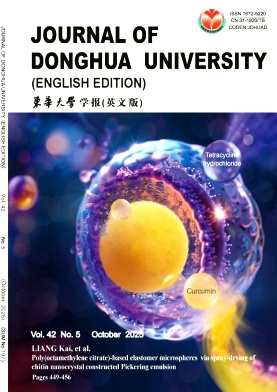
Tracking the information about your manuscript
Communicate with the editorial office
Query manuscript payment status Peer ReviewOnline Review
Online Communication with the Editorial Department Editorial OfficeCollecting, editing, reviewing and other affairs offices
Managing manuscripts
Managing author information and external review Expert Information
Download Center
Call for Papers
News
OSID Open Science Program
JDHUE Selected for CAS 2024 “Bilingual Communication Project of Scientific Journals”
JDHUE Selected for Shanghai Scientific Journals' Most Beautiful Cover Case Library
JDHUE Editorial Department Presents Thesis Writing Lecture for Graduate Students in the College of Chemistry and Chemical Engineering at DHU
JDHUE Editorial Department Presents Scientific Paper Writing Standards Lecture for International Students at DHU
more..Links
Subscription
Journal information
Journal of Donghua University (English Edition)
Started: 1984
Supervised by: Ministry of Education, China
Administered by : Donghua University
Editor-in-Chief: Zhu Meifang
CN: 31-1920/TS
ISSN: 1672-5220

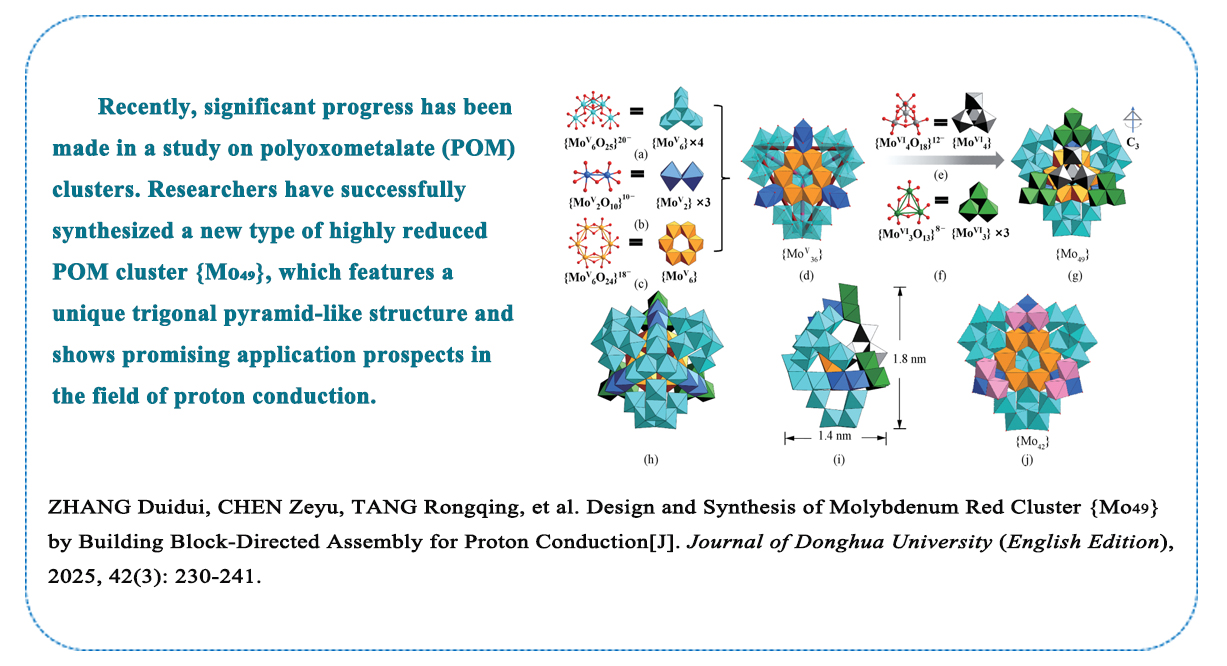

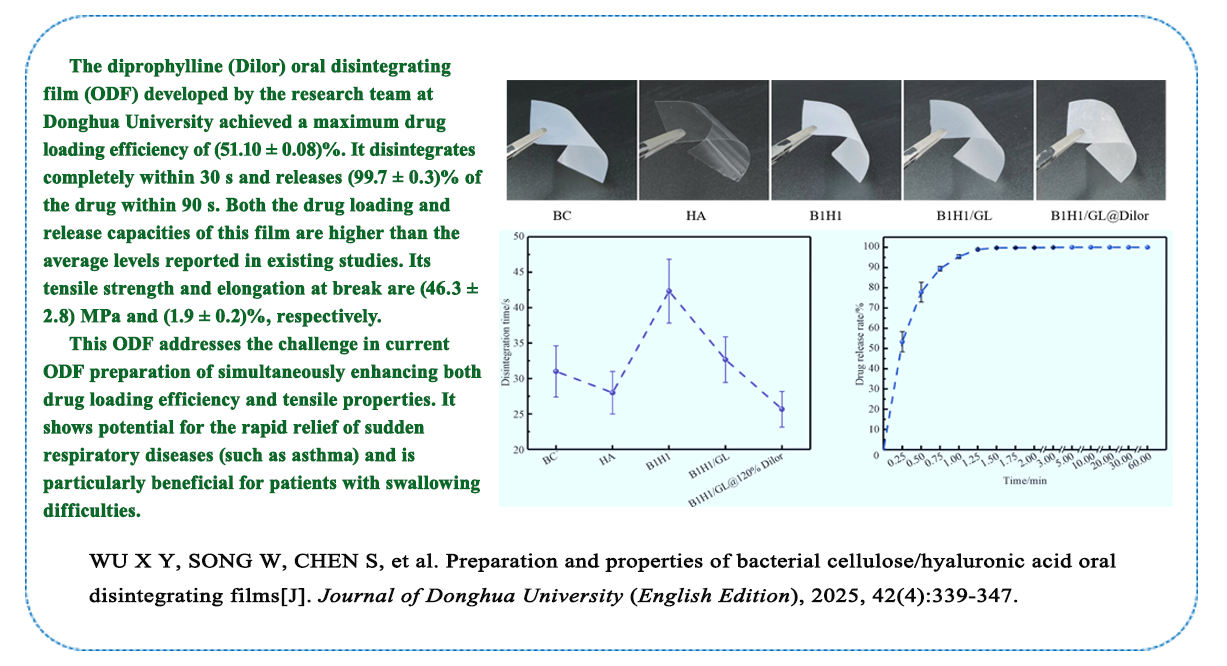
-Based Elastomer Microspheres via Spray-Drying of.jpg)

